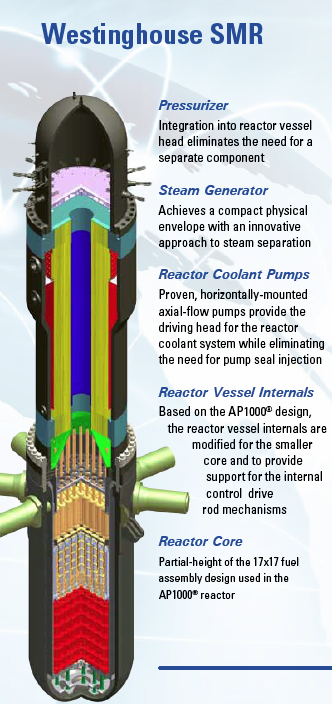Small nuclear reactors: America's energy future?


Small Modular Reactor (SMR) concepts could help make future nuclear power plants in the United States safer and easier to construct while helping to recycle stockpiles of existing uranium fuel waste.
The general idea behind SMRs is to cluster together many small reactors to match the output of obsolete coal or nuclear facilities. Steam output from many modules would power a common generator to produce electricity.
Each module would be equipped with its own containment assembly that’s housed in a pre-fabricated unit. Think of it as a nuclear assembly line.
A module would be small enough to be shipped to a new reactor build by rail or truck rather than assembly components inside of a containment dome onsite.
All-in-one fabrication would streamline nuclear power plant construction by several years, said Steve Rus, executive director for nuclear technologies at Black & Veatch. SMRs would be housed in a steel and concrete embedment that resides below grade.
B&V has had a sizeable nuclear business since World War II.
Small modular reactor designs are also supported by the Obama administration, which sees nuclear power as a way to reduce carbon emissions. However, the public is understandably warier of nuclear power post Fukushima, and would need some reassurances of its safety.
The SMR addresses the greatest perceived danger - nuclear meltdowns – a threat that has loomed since the dawn of the nuclear era. It doesn’t require active cooling systems to prevent a meltdown, and would theoretically shut down safely without any outside intervention.
Traditional active cooling systems at large scale reactors utilize water pumps and back-up power systems to control residual or decay heat after a reaction is stopped. An external power source and/or coolant are eventually necessary within a matter of days.
Recent third generation+ reactor designs incorporate passive cooling technologies with traditional active cooling techniques, but that approach only buys more time until there’s meltdown conditions.
Several reactors at Tokyo Electric Power’s Fukushima plants melted down when diesel back-up systems failed and mainland power lines were destroyed in the wake of twin natural disasters. It was reliant on active cooling, and its engineers hadn’t envisioned a tsunami striking far inland.
A module reactor’s passive cooling system could theoretically survive that scenario, and non-water cooling systems could further increase margins of safety.
“The concept is these could go on almost indefinite periods in passive manner with no intervention relative to the cooling of core and decay/residual heat. Potentially, it could never require any additional intervention,” Rus said.
The initial SMRs will continue to utilize water for cooling and uranium fuel, but sodium and lead bismuth alloys could foreseeably replace water in fourth generation models – provided they pass Nuclear Regulatory Commission (NRC) review, Russ said.
The NRC’s regulators are very familiar with light water reactors, but alternative fuel sources would require different cooling methods, Rus said. Thorium is arguably safer than uranium both in the risk of accidents and for nuclear nonproliferation.
“The coolant form is different than water, therefore there’s natural benefits in the way it cools reactor,” Rus explained. A sodium coolant would be liquid under normal operating conditions, but solidify and encase the reactor upon a cold shutdown. Molten salt is also a potential future fuel source.
Aside from the NRC's institutional history, uranium's other advantage is that there’s also an abundance of fuel in the form of nuclear waste that is being sequestered at nuclear facilities around the United States. Spent fuel rods could become a source of energy for newer generation reactors, Rus suggested.
“More than 90 percent of the energy is still in that fuel. One thing that has to come to life is recycling. After reprocessing, waste is significantly less, and then there ultimately needs to be a way to address that waste.”
More nuclear future on SmartPlanet:
- Meet the future of nuclear power: 8 guys in China
- How nuclear will make oil greener
- Documentary: How we missed out on a “limitless” supply of an exotic nuclear power
- The new face of safe nuclear
- America's nuclear future
This post was originally published on Smartplanet.com